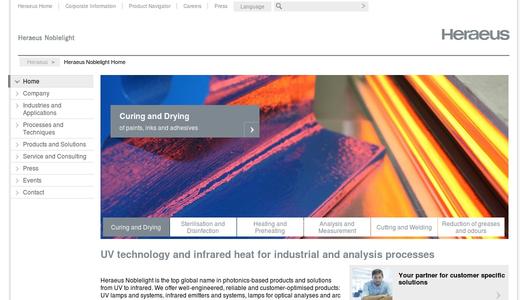Heraeus Noblelight is showing contoured infrared emitters for the targeted heating of edges and borders at Fakuma in Friedrichshafen in October 2015.
Car carpets generally consist of a polyester topside with a rubber underside. The underside is made non-slip by means of pimples or similar structures. The topside fleece could fray after the mats are cut to size. Conventionally, its edges are crimped with a heated tool to prevent this. By using infrared emitters, it is no longer necessary to pre-heat the tool. An emitter, which is shaped exactly to the shape of the carpet edge, heats this edge in seconds before the edge is crimped by the crimping tool. This contact-free infrared heating, using precisely shaped emitters, can reduce production cycle times to 15 to 20 seconds. Quartz glass infrared emitters can be used in the production of edges and borders. They apply heat so precisely, exactly where it is needed, without heating the rest of the foot mat. This minimizes heating damage and saves energy.
Heating plastics in seconds, without contact, and in a targeted manner
The wide range of processes used in plastics processing can now be carried using infrared heating technology. Infrared emitters are already well-established in the rapid, homogenous heating of large, flat surfaces. However, there is a real challenge in manufacturing processes where only very small or curved surfaces, edges, borders or defined contours of the product need to be heated. Why is it necessary to heat up complete car doors, steering wheels or foot mats when only a few centimeters of these products require heat.
Plastic components can be joined by infrared heating without the need for adhesives or other joining mechanisms. The infrared radiation melts a thin surface layer of the individual plastic parts in a short time. The parts are then joined by simply pressing them together to form products such as windscreen washer water or brake fluid reservoirs. In contrast with contact welding using hot plates, no excess material clings to the heat source and heating stage takes place in seconds and is repeatable.
Plastic handles, housing parts, air intakes or covers are often injection moulded. Very often it is impossible to prevent the creation of sharp-edged burrs, especially in the tool separation plane. Shaped infrared emitters precisely melt away only the burr, without damaging the actual work piece. As a result, they are superior to many conventional methods, such as manual removal with special blades or by the use of gas flames, which do not produce repeatable results and take considerable time.
Heraeus meets the challenge of applying energy efficiently even for difficult manufacturing operations with a comprehensive portfolio of emitters. These are focused on the specific process in terms of design, size and radiation spectrum. Heat is generated exactly where it is required. Consequently, energy loss to the immediate environment is extremely small, cycle times can be reduced or more parts can be produced in the same time.
Heraeus, the technology group headquartered in Hanau, Germany, is a leading international family-owned company formed in 1851. With expertise, a focus on innovations, operational excellence and an entrepreneurial leadership, we strive to continuously improve our business performance.
We create high-quality solutions for our clients and strengthen their competitiveness in the long term by combining material expertise with technological know-how. Our ideas are focused on themes such as the environment, energy, health, mobility and industrial applications. Our portfolio ranges from components to coordinated material systems which are used in a wide variety of industries, including the steel, electronics, chemical, automotive and telecommunications industries.
In the 2014 financial year, Heraeus generated product revenues of €3.4 bn and precious metal revenues of €12.2bn euros. With around 12,600 employees worldwide in more than 100 subsidiaries in 38 countries, Heraeus holds a leading position in its global markets.


